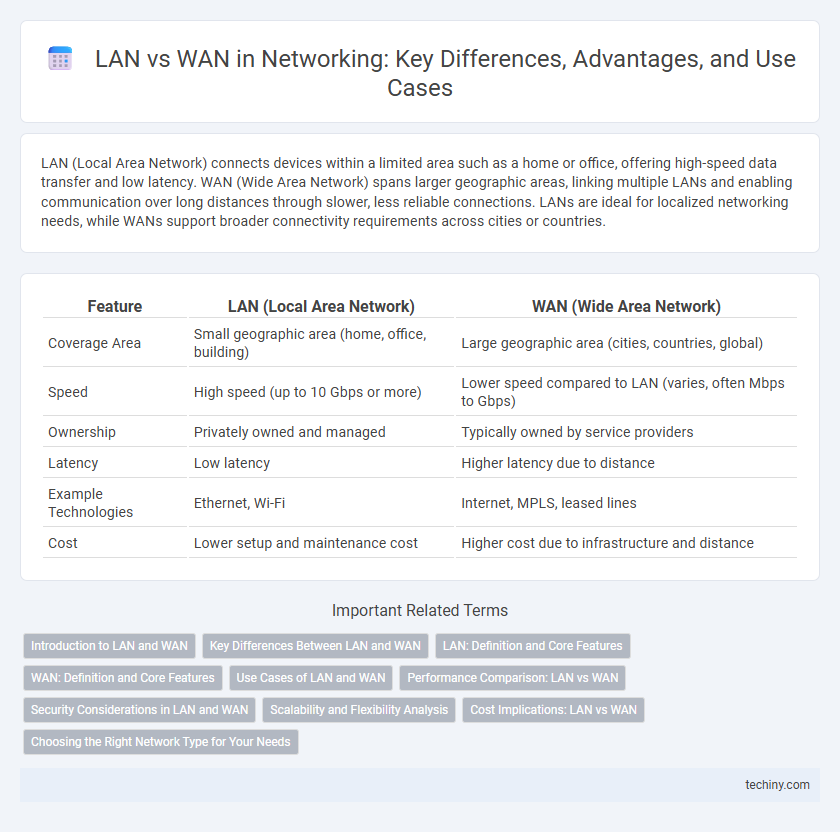LAN (Local Area Network) connects devices within a limited area such as a home or office, offering high-speed data transfer and low latency. WAN (Wide Area Network) spans larger geographic areas, linking multiple LANs and enabling communication over long distances through slower, less reliable connections. LANs are ideal for localized networking needs, while WANs support broader connectivity requirements across cities or countries.
Table of Comparison
| Feature | LAN (Local Area Network) | WAN (Wide Area Network) |
|---|---|---|
| Coverage Area | Small geographic area (home, office, building) | Large geographic area (cities, countries, global) |
| Speed | High speed (up to 10 Gbps or more) | Lower speed compared to LAN (varies, often Mbps to Gbps) |
| Ownership | Privately owned and managed | Typically owned by service providers |
| Latency | Low latency | Higher latency due to distance |
| Example Technologies | Ethernet, Wi-Fi | Internet, MPLS, leased lines |
| Cost | Lower setup and maintenance cost | Higher cost due to infrastructure and distance |
Introduction to LAN and WAN
Local Area Network (LAN) connects devices within a limited geographic area such as homes, offices, or buildings, offering high-speed data transfer and low latency. Wide Area Network (WAN) spans larger geographic regions, linking multiple LANs through telecommunications or satellite links, often with lower speed and higher latency compared to LAN. LANs are typically managed by local administrators, whereas WANs require service providers to facilitate inter-network communication.
Key Differences Between LAN and WAN
LAN (Local Area Network) typically covers a small geographic area such as a home, office, or building, offering high-speed connectivity and low latency. WAN (Wide Area Network) spans large geographical distances, often connecting multiple LANs via public or private networks with relatively lower speeds and higher latency. The key differences lie in coverage area, speed, reliability, cost, and technology used, with LANs generally being faster and more cost-effective for localized networking.
LAN: Definition and Core Features
A Local Area Network (LAN) is a network that connects devices within a limited geographic area, such as a home, office, or campus, enabling high-speed data transfer and resource sharing. Key features include low latency, high bandwidth, and the use of Ethernet or Wi-Fi technologies for connectivity. LANs support centralized management, facilitating efficient communication between computers, printers, and servers within the localized environment.
WAN: Definition and Core Features
A Wide Area Network (WAN) connects multiple Local Area Networks (LANs) across large geographical distances, enabling extensive data communication and resource sharing. Core features of WAN include scalability, high latency tolerance, diverse transmission media such as satellite, fiber optics, and leased lines, and robust routing protocols like MPLS and BGP for efficient data traffic management. WANs support critical enterprise functions by providing flexible connectivity, secure remote access, and reliable communication between dispersed organizational branches.
Use Cases of LAN and WAN
Local Area Networks (LANs) are ideal for connecting devices within limited geographic areas like homes, offices, and campuses, providing high-speed data transfer and low latency for activities such as file sharing, printer access, and internal communication. Wide Area Networks (WANs) connect multiple LANs across broader geographic regions, enabling remote office connectivity, Internet access, and large-scale data exchange crucial for enterprises with distributed operations. LANs prioritize speed and security within confined spaces while WANs emphasize reach and scalability over long distances.
Performance Comparison: LAN vs WAN
LANs offer significantly higher data transfer speeds, typically ranging from 100 Mbps to 10 Gbps, due to their limited geographic coverage and use of high-speed Ethernet technology. WANs cover broader areas, often connecting multiple LANs across cities or countries, resulting in slower speeds around 1 Mbps to 1 Gbps caused by longer distances and reliance on public infrastructure like fiber optics or satellite links. Network latency and packet loss are generally lower in LANs, contributing to better overall performance and reliability compared to WANs.
Security Considerations in LAN and WAN
LAN security typically involves safeguarding a confined network through strong access controls, internal firewalls, and authentication protocols to prevent unauthorized access within an organization. WAN security requires robust encryption methods, virtual private networks (VPNs), and intrusion detection systems to protect data transmitted over expansive, often public networks susceptible to interception and cyberattacks. Both LAN and WAN demand continuous monitoring, but WAN faces greater risks due to its extensive reach and reliance on multiple service providers and infrastructure.
Scalability and Flexibility Analysis
LANs offer high scalability within localized environments, supporting numerous devices with minimal latency and efficient resource management. WANs provide greater flexibility for connecting geographically dispersed networks, accommodating diverse protocols and dynamic routing. Scalability in WANs relies on robust infrastructure and bandwidth management to maintain performance across extended distances.
Cost Implications: LAN vs WAN
Local Area Networks (LANs) typically incur lower costs due to limited geographic coverage, reduced infrastructure requirements, and simpler maintenance. Wide Area Networks (WANs) demand higher investments for long-distance communication, including leased telecommunication lines, advanced routing hardware, and ongoing service fees. Organizations must evaluate bandwidth needs and geographic scale to balance cost efficiency between LAN and WAN implementations.
Choosing the Right Network Type for Your Needs
Selecting between LAN and WAN depends on the scope and scale of your networking requirements; LANs offer high-speed, low-latency connections ideal for localized environments like offices or campuses, whereas WANs enable communication over broad geographic areas using various transmission technologies. Consider factors such as data transfer speed, security protocols, latency tolerance, and cost-effectiveness when determining the network type that aligns with your organizational goals and infrastructure. For applications requiring fast internal communication and controlled environments, LANs are preferable, while WANs are necessary for connecting remote sites and supporting wide-area data exchange.
LAN vs WAN Infographic

 techiny.com
techiny.com